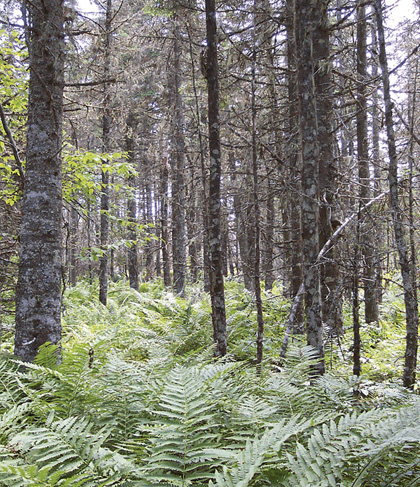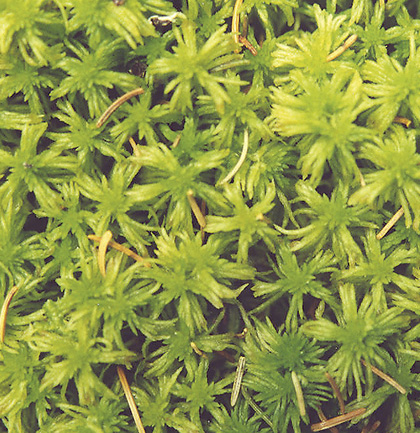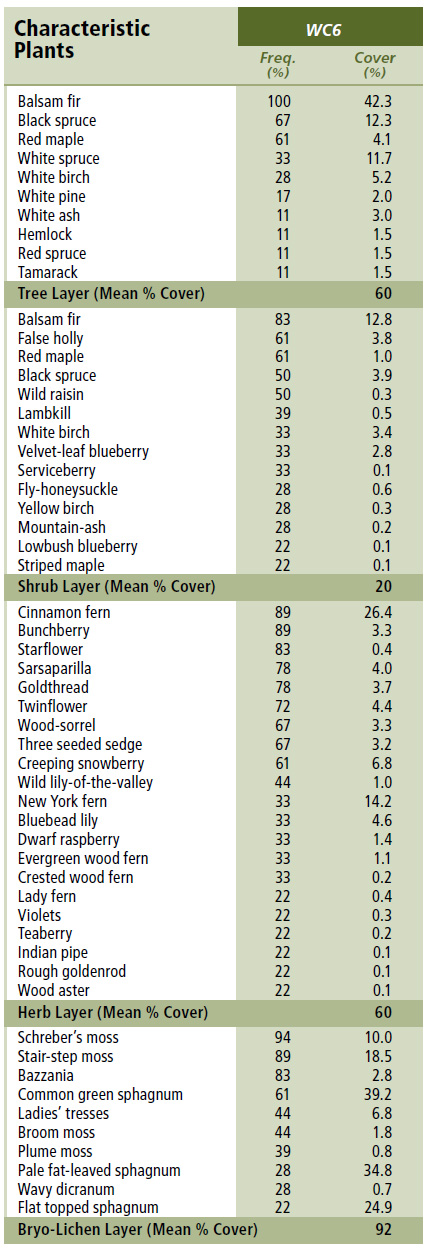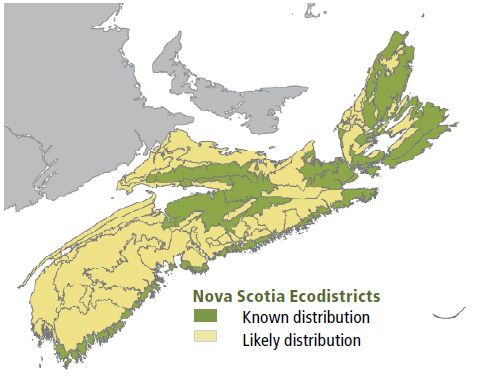
Forest Vegetation types - WC6
WC6 — Balsam fir / Cinnamon fern – Three seeded sedge / Sphagnum
Abies balsamea / Osmunda cinnamomea – Carex trisperma / Sphagnum spp.
 |
Mount Thom, Pictou County |
Concept: This coniferous forest is characterized by balsam fir canopy dominance and high sphagnum moss cover. The early to mid-successional ecosystem is generally associated with wet soils, but may occur on imperfectly drained sites. Low to moderate nutrient availability is typical but this Vegetation Type (VT) is usually on richer sites than wet black spruce – pine forests (WC1 - WC4).
Vegetation: Canopy layers are usually well developed, but some stands are open with stunted and/or more widely-spaced trees. The canopy is heavily dominated by balsam fir. Other important co-dominants may include white spruce, black spruce and/or red maple. The shrub layer is variably developed but usually supports low to moderate cover. Few woody shrubs are frequent. False holly, wild raisin and/or lambkill may be sparsely scattered but they are not especially prominent. Herbaceous cover is moderate, largely comprised of wet site species (e.g. cinnamon fern, three seeded sedge) and common upland coniferous forest plants. Sphagnum species dominate the dense bryophyte layer. Common green and ladies' tresses sphagnum mosses are typical.
Environmental Setting: The Balsam fir / Cinnamon fern - Three seeded sedge / Sphagnum forest occurs on poorly drained flats, in shallow depressions and on gentle to moderate slopes. Most sites are at least moderately exposed and have very little microtopography. Cooler slopes are favoured, but aspect is somewhat variable. Soils are usually derived from glacial tills, but organic deposits also provide suitable habitat. Low to moderate nutrient availability is typical. The VT is primarily found scattered throughout central and eastern Nova Scotia. WC6 is widespread throughout the Maritime Provinces.
Successional Dynamics: In cooler highland and coastal ecoregions, the forest may persist as a type of edaphic climax but elsewhere, it will succeed to WC5 (Red spruce – Balsam fir/ Cinnamon fern / Sphagnum) or WC8 (Hemlock / Cinnamon fern – Sensitive fern / Sphagnum). Depending on disturbance regime and the local ecological context, WC6 could also transition to WD2 (Red maple / Cinnamon fern / Sphagnum), WD6 (Red maple – Balsam fir / Wood aster / Sphagnum), WD8 (Red spruce – Red maple / Wood sorrel – Sensitive fern / Sphagnum) or even CE1 (Eastern white cedar / Speckled alder / Cinnamon fern / Sphagnum). Common disturbance agents are tree mortality caused by windthrow, timber harvest and spruce budworm defoliation.
Ecological Features: The Balsam fir / Cinnamon fern – Three seeded sedge / Sphagnum forest occurs as a small patch in larger upland conifer or mixedwood forests, at the edge of open wetlands, or adjacent to other types of wet forest. The ecosystem is characterized by moderate to high canopy development, usually sparse woody understory cover but generally dense herbaceous and bryophyte cover. Old growth potential is low but may be higher in cooler or sheltered areas, less prone to patch and stand-replacing disturbance. In cooler areas, this ecosystem may persist as a type of edaphic climax, representing an important component of landscape structure, but successional dynamics are not completely understood. Similar to all wet forests, this ecosystem supports valuable habitat, distinct ecological features and unique biogeochemical functions. Documented rare plant associates include: creeping rattlesnake plantain, showy lady's slipper, meadow horsetail and foamflower.
 |
| Common green sphagnum |
Distinguishing Features: This is a poorly drained softwood forest dominated by balsam fir with occasional spruces and red maple. Cinnamon fern and three seeded sedge are common herbs, while sphagnum mosses dominate the groundcover.
| Slope Position: | Level7 Middle2 Lower1 |
Surface Stoniness: |
(Non - Slightly)8 (Moderately)1 (Very - Excessively)1 |
Bedrock Outcrop: |
(Non-rocky)10 |
Elevation Range: |
6 - 445m |
Slope Gradient: |
Level7 Gentle3 |
Aspect: |
North2 South2 None6 |
Exposure: |
Moderate4 Exposed3 Mod. exposed2 Other1 |
Microtopography: |
Level6 Slightly3 nd1 |
Drainage: |
Poor6 Very poor3 Imperfect1 |
Soil Type: |
ST43 ST143 ST31 ST61 ST71 ST131 |
Parent Material: |
Glacial till6 Organic3 Lacustrine1 |
Rooting Depth (cm): |
(<30)6 (30-45)2 (>45)1 nd1 |
Duff Thickness (cm): |
(6-10)1 (11-20)2 (21-40)2 (>40)2 nd3 |

